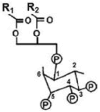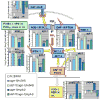Extreme-longevity mutations orchestrate silencing of multiple signaling pathways
- PMID: 19465083
- PMCID: PMC2885961
- DOI: 10.1016/j.bbagen.2009.05.011
Extreme-longevity mutations orchestrate silencing of multiple signaling pathways
Abstract
Long-lived mutants provide unique insights into the genetic factors that limit lifespan in wild-type animals. Most mutants and RNA interference targets found to extend life, typically by 1.5- to 2.5-fold, were discovered in C. elegans. Several longevity-assurance pathways are conserved across widely divergent taxa, indicating that mechanisms of lifespan regulation evolved several hundred million years ago. Strong mutations to the C. elegans gene encoding AGE-1/PI3KCS achieve unprecedented longevity by orchestrating the modulation (predominantly silencing) of multiple signaling pathways. This is evident in a profound attenuation of total kinase activity, leading to reduced phosphoprotein content. Mutations to the gene encoding the catalytic subunit of PI3K (phosphatidylinositol 3-kinase) have the potential to modulate all enzymes that depend on its product, PIP3, for membrane tethering or activation by other kinases. Remarkably, strong mutants inactivating PI3K also silence multiple signaling pathways at the transcript level, partially but not entirely mediated by the DAF-16/FOXO transcription factor. Mammals have a relatively large proportion of somatic cells, and survival depends on their replication, whereas somatic cell divisions in nematodes are limited to development and reproductive tissues. Thus, translation of longevity gains from nematodes to mammals requires disentangling the downstream consequences of signaling mutations, to avoid their deleterious consequences.
Figures






Similar articles
-
Positive feedback between transcriptional and kinase suppression in nematodes with extraordinary longevity and stress resistance.PLoS Genet. 2009 Apr;5(4):e1000452. doi: 10.1371/journal.pgen.1000452. Epub 2009 Apr 10. PLoS Genet. 2009. PMID: 19360094 Free PMC article.
-
Activated AKT/PKB signaling in C. elegans uncouples temporally distinct outputs of DAF-2/insulin-like signaling.BMC Dev Biol. 2006 Oct 4;6:45. doi: 10.1186/1471-213X-6-45. BMC Dev Biol. 2006. PMID: 17020605 Free PMC article.
-
Caenorhabditis elegans PI3K mutants reveal novel genes underlying exceptional stress resistance and lifespan.Aging Cell. 2009 Dec;8(6):706-25. doi: 10.1111/j.1474-9726.2009.00524.x. Epub 2009 Sep 17. Aging Cell. 2009. PMID: 19764929 Free PMC article.
-
DAF-16: FOXO in the Context of C. elegans.Curr Top Dev Biol. 2018;127:1-21. doi: 10.1016/bs.ctdb.2017.11.007. Epub 2018 Feb 2. Curr Top Dev Biol. 2018. PMID: 29433733 Review.
-
The search for DAF-16/FOXO transcriptional targets: approaches and discoveries.Exp Gerontol. 2006 Oct;41(10):910-21. doi: 10.1016/j.exger.2006.06.040. Epub 2006 Aug 24. Exp Gerontol. 2006. PMID: 16934425 Review.
Cited by
-
Mechanistic insights into aging, cell-cycle progression, and stress response.Front Physiol. 2012 Jun 4;3:183. doi: 10.3389/fphys.2012.00183. eCollection 2012. Front Physiol. 2012. PMID: 22675309 Free PMC article.
-
Expression level drives the pattern of selective constraints along the insulin/Tor signal transduction pathway in Caenorhabditis.Genome Biol Evol. 2011;3:715-22. doi: 10.1093/gbe/evr071. Epub 2011 Aug 17. Genome Biol Evol. 2011. PMID: 21849326 Free PMC article.
-
A narrow quantitative trait locus in C. elegans coordinately affects longevity, thermotolerance, and resistance to paraquat.Front Genet. 2011 Sep 27;2:63. doi: 10.3389/fgene.2011.00063. eCollection 2011. Front Genet. 2011. PMID: 22303358 Free PMC article.
-
Genetic studies reveal the role of the endocrine and metabolic systems in aging.J Clin Endocrinol Metab. 2010 Oct;95(10):4493-500. doi: 10.1210/jc.2010-0859. J Clin Endocrinol Metab. 2010. PMID: 20926537 Free PMC article. Review.
-
Integrating evolutionary and molecular genetics of aging.Biochim Biophys Acta. 2009 Oct;1790(10):951-62. doi: 10.1016/j.bbagen.2009.07.010. Epub 2009 Jul 18. Biochim Biophys Acta. 2009. PMID: 19619612 Free PMC article. Review.
References
-
- Klass MR. A method for the isolation of longevity mutants in the nematode Caenorhabditis elegans and initial results. Mech Ageing Dev. 1983;22:279. - PubMed
-
- Lin K, Hsin H, Libina N, Kenyon C. Regulation of the Caenorhabditis elegans longevity protein DAF-16 by insulin/IGF-1 and germline signaling. Nature Genetics. 2001;28:139. - PubMed
-
- Apfeld J, Kenyon C. Regulation of lifespan by sensory perception in Caenorhabditis elegans. Nature. 1999;402:804. - PubMed
-
- Lin K, Dorman JB, Rodan A, Kenyon C. daf-16: An HNF-3/forkhead family member that can function to double the life-span of Caenorhabditis elegans. Science. 1997;278:1319. - PubMed
Publication types
MeSH terms
Substances
Grants and funding
LinkOut - more resources
Full Text Sources
Miscellaneous

